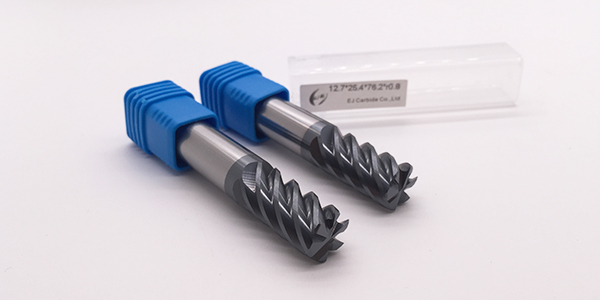Basic knowledge of milling cutters,carbide end mill
(1) High hardness and wear resistance: At normal temperature, the cutting part must have sufficient hardness to cut into the workpiece; it has high wear resistance, the tool does not wear and prolongs the service life.
(2) Good heat resistance: The tool will generate a lot of heat during the cutting process, especially when the cutting speed is high, the temperature will be very high. Therefore, the tool material should have good heat resistance, both at high temperature. It still maintains high hardness and has the ability to continue cutting. This high temperature hardness is also called thermosetting or red hardness.
(3) High strength and good toughness: During the cutting process, the tool has to bear a large impact force, so the tool material should have high strength, otherwise it is easy to break and damage. Since the milling cutter is subject to shock and vibration, the milling cutter material should also have good toughness, so that it is not easy to chip and chip.

2. Common materials for milling cutters
(1) High-speed tool steel (referred to as high-speed steel, front steel, etc.), divided into general-purpose and special-purpose high-speed steel. It has the following characteristics:
a. The alloying elements are high in tungsten, chromium, molybdenum and vanadium, and the quenching hardness can reach HRC62-70. At 6000C high temperature, it still maintains high hardness.
b. Good edge strength and toughness, strong vibration resistance, can be used to manufacture tools with general cutting speed. For machine tools with poor steel quality, high-speed steel milling cutter can still be used for smooth cutting.
c. Good process performance, forging, machining and sharpening are relatively easy, and it is also possible to manufacture tools with more complicated shapes.
d. Compared with cemented carbide materials, there are still shortcomings such as low hardness, poor red hardness and wear resistance.
(2) Cemented carbide: It is made of metal carbide, tungsten carbide, titanium carbide and cobalt-based metal binder by powder metallurgy. Its main features are as follows:
It can withstand high temperature and maintain good cutting performance around 800-10000C. It can be used for cutting speed 4-8 times higher than high speed steel. High hardness at room temperature and good wear resistance.
The bending strength is low, the impact toughness is poor, and the blade is not sharp to be sharp.
Commonly used tungsten carbide can generally be in three categories:
1 tungsten-cobalt hard alloy (YG)
Commonly used grades YG3, YG6, YG8, where the number indicates the percentage of cobalt content, the more cobalt content, the better the toughness, the more resistant to impact and vibration, but it will reduce the hardness and wear resistance. Therefore, the alloy is suitable for cutting cast iron and non-ferrous metals, and can also be used to cut impact-resistant blanks and hardened steel and stainless steel parts.
2 Titanium-cobalt hard alloy (YT)
Commonly used grades are YT5, YT15, YT30, and the numbers indicate the percentage of titanium carbide. After the cemented carbide contains titanium carbide, it can increase the bonding temperature of the steel, reduce the friction coefficient, and can slightly improve the hardness and wear resistance, but reduce the bending strength and toughness, and make the property brittle. Therefore, Alloys are suitable for cutting steel parts.
3 general purpose hard alloy
Adding appropriate amount of rare metal carbides, such as tantalum carbide and tantalum carbide, to the above two kinds of cemented carbides to refine the grains, and improve their normal temperature hardness and high temperature hardness, wear resistance, bonding temperature and oxidation resistance. It can increase the toughness of the alloy. Therefore, this type of hard alloy knives has better comprehensive cutting performance and versatility. Its grades are: YW1, YW2 and YA6. Due to its high price, it is mainly used for difficult. Processing materials such as high-strength steel, heat-resistant steel, stainless steel, etc.
3. Types of milling cutters
(1) According to the material of the cutting part of the milling cutter:
a, high-speed steel milling cutter: more complex tools use this type.
b. Carbide milling cutters: Most of them are welded or mechanically clamped to the cutter body.
(2) According to the purpose of the milling cutter:
a. Machining plane milling cutter: cylindrical milling cutter, end milling cutter, etc.
b. Milling cutters for machining grooves (or steps): end mills, disc cutters, saw blades, etc.
c. Milling cutters for special surfaces: forming cutters, etc.
Related tools:
Carbide endmill
Carbide drill bit
Carbide insert
